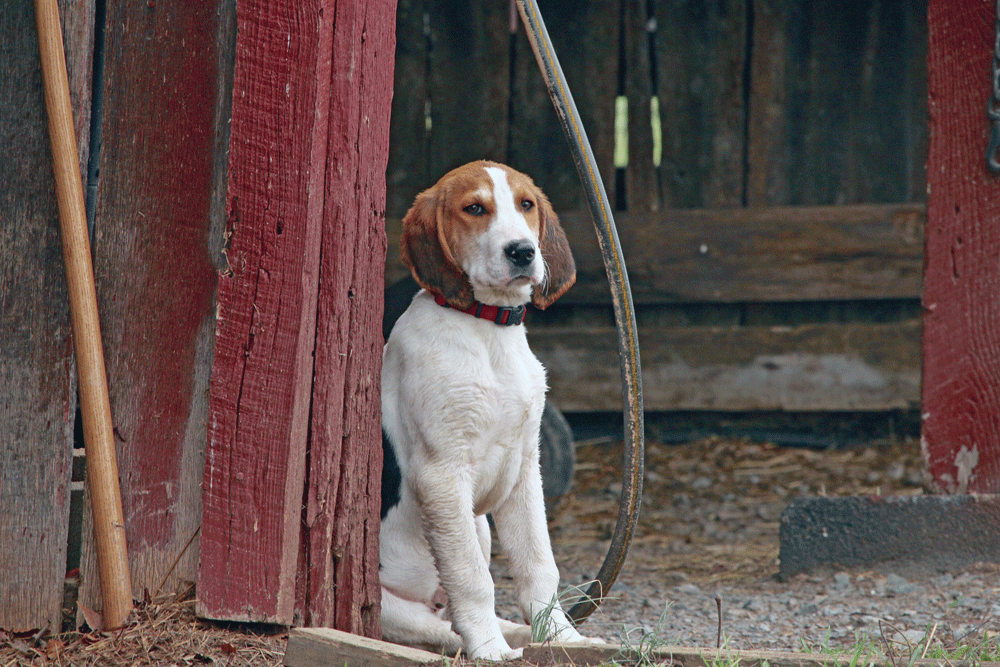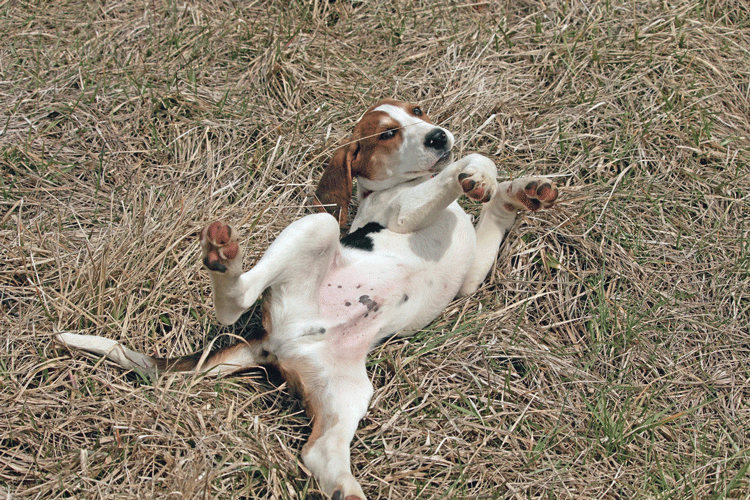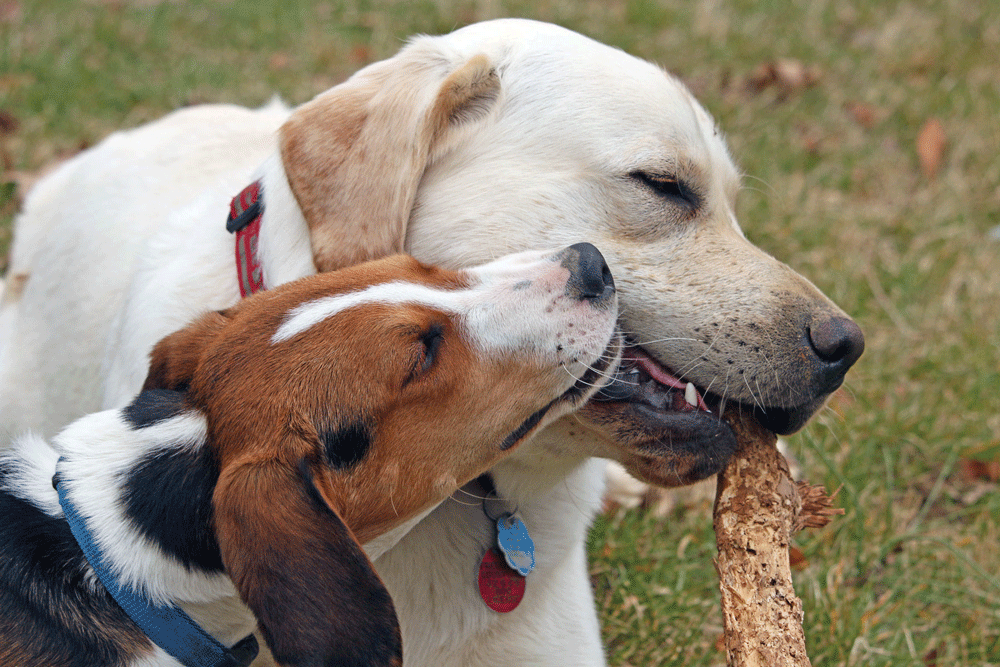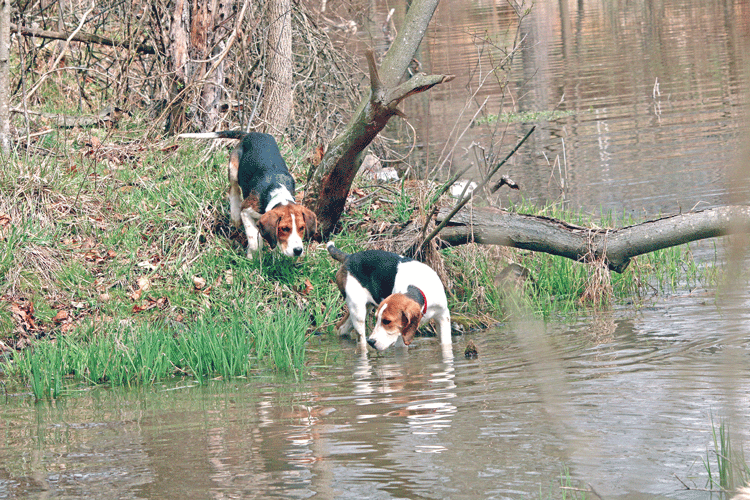Puppy Walkers

Story and photos by Martha Wolfe
Doris Stimpson, former Master of Blue Ridge Hunt, calls Puppy Walkers saints.

“Here’s how it goes,” she says. “We give you two adorable puppies and say, ‘Be careful, don’t let them get hurt or hurt themselves. We aren’t going to give you any money or compensate you, but you must feed them and keep them healthy. They’ll steal everything, destroy what they will, eat anything, so watch out. And, by the way, don’t get attached, because we’re coming to take them back!’”
Who are these sainted individuals? These “Puppy Walkers?”
Puppy Walkers are folks who voluntarily open their homes to the most irksome, sneakiest, reckless, tireless, happiest, adorable, heart-warming creatures on earth: foxhound puppies. “Going to walk” is the age-old expression used when huntsmen and Masters beg members of their hunts, neighbors, friends and relations to take a couple of pups home for a time, as long as they can humanly stand the little terrorists. They are called a “couple” because later they will be literally coupled in a double collar to an older, more experienced hound that will teach them to hunt.

Why ask this task of reasonable people? Because in order to make a good hunting hound, one with independence and curiosity, without timidity or fear of the unknown, a foxhound puppy needs to spend its first few months of life away from the kennels immersed in country life.
The average litter size for a foxhound is around eight, and every spring, about this time, each hunt has more than one litter of pups. They spend the first eight weeks separated from the rest of the pack in a quiet warm whelping room at the kennels with their mothers. William Somervile, writing in 1735, advises Masters and huntsmen to, “Dignify their little charges with some great title, and resounding name of high import.” At around six weeks they are weaned and move outside to live in a little yard all their own. Then at eight weeks they “go out to walk.” They won’t begin their hunting careers until they are about 18 months.
The huntsman will deliver them, or you can pick them up, but make sure they’re in a secure crate. It’s fun to watch the faces of other drivers as you sail along to the music of howling hounds in the back of your truck.
Make them a nice bed in a stall or a pen with a shelter. It’s best if they sleep on a platform or bench “about a foot off the ground,” according to Amy Charlotte Bewicke Menzies, who wrote a delightful book on
foxhunting, “Women In The Hunting Field,” in 1913. She lines their bed with clean straw or “bracken fern,” reminding us never to let them sleep on a warm steaming pile of manure, which they are inclined to do.
Of course our modern pups are vaccinated before they leave the kennels, but Somervile and Menzies necessarily worried about rabies and distemper and other deadly viruses and infections. “Feed them three meals a day beginning with stale bread soaked in warm milk, followed by meat broth with cabbage and a puppy biscuit or well-cooked rice, and lastly warm milk with oatmeal.” She advises making your broth “from horseflesh, mutton, household bones or anything convenient” and recommends a daily pint of buttermilk each. These days we can be safe with a bag of nice fresh puppy chow!

But your main job is to show them the world. “Find a home well back from the main road,” Alexander Mackay-Smith writes in “Foxhunting In North America.” “Put on a collar and teach them to lead. Expose them to cats, chickens, horses, cattle, sheep, pigs.” Add donkeys, goats, ducks and geese to that list with tractors, rakes, pitchforks, plows, wheelbarrows, hay-bines and harvesters. “Take them through briar patches, across streams, over stone walls, and chicken coop panels,” Mackay-Smith writes. “Consider future land owners across whose land these hounds will someday run.” If a pup chases your sheep, Somervile advises tying him to a ram and letting it drag the brat around for a while, reminding Puppy Walkers from the 18th to the 21st century that “vicious habits, late correction shall never reclaim.”
You must teach them to come when they are called; it helps to have a cookie in your pocket at all times. Other commands they must learn fall into the category of “things you will say to your dog but not your girlfriend,” such as, “Off!” and “Leave It!” and “Down Girl Down!”
Linda Armbrust, former Master at Blue Ridge, reckons she has walked around 90 couple of hounds in her long foxhunting career. “They really have to go out to walk,” she says. “The difference in hounds raised in a kennel and those that are walked is remarkable. If they aren’t, then the first time they see the wide world is the first day they go hunting. They’re just different.”
Armbrust built a pen in her barn for her many couple of pups. “They came and went out the back of the house,” she says. One of her pups made a habit of going to the neighbor’s house and crashing through the screen door to steal whatever might have been on the kitchen counter. “I had to send that one back. The neighbors didn’t look too kindly on that,” she says.
A couple of days after they arrive and settle in, the trouble starts. Roger Williams understates the problems in his book “Horse And Hound”: “The weakness and propensity of a hound pup for appropriation and theft is well known to all.” In other words, watch your stuff.
“You must be prepared for long lists of things that have disappeared, been eaten and broken, a small half of which you can safely put down to puppies,” Menzies writes. “A stable sponge as an hors d’oeuvre, followed by a boot or shoe; failing that, a glove does not come amiss, while for the pièce de résistance, a doormat is much enjoyed, after which a young chicken or two as a savory.”
Menzies tells of a Gloucester farmer who took a couple of pups for the summer. Tired of the little pests and wishing for a moment of peace, he locked them in his cider cellar and went off for a nap. When he returned he found them swimming in a couple of feet of cider, having pulled the stops out of all the barrels. She became worried about another couple of pups in her own care when they began to refuse all food, though they remained “fat and frisky with shiny coats.” She soon discovered they had been stealing and gorging themselves on eggs from the coop.

Iona Pillion has been walking puppies for Blue Ridge since the early 1970s. This year she has a shy little girl named Aniseed, who everyone insists on calling Anus. The puppies are no end of joy and trouble. “They drag things off,” she says, rolling her eyes. “Horse blankets, gloves, martingales…once you find their hiding place, you can get it all back.” But their capers can get really expensive. “One couple used to drag stuff under the horse trailer to make a bed,” she says. “They proceeded to rip all the wires out from under the trailer—brake and electric wires— it was costly!”
But she clearly loves them. “I take my grandson over to see the puppies at the kennels…a little boy surrounded by happy, licking puppies,” she says. “His mother isn’t too happy, but his grandfather, Bobby [former whip for Blue Ridge], would have been very pleased.”
Considering their shenanigans one is inclined to give a hound pup a smack on the snout or a kick with the boot they just stole. But be careful because they are often shy and always sensitive. “They can read your facial expressions and refuse to acknowledge you,” Menzies explains.
Most Puppy Walkers find that it’s hard to stay mad at the little darlings; they are so hilarious and full of life’s joy. “It goes against the grain to repress and teach them,” Menzies writes. “It is so blessed to see anything really happy, even for one brief hour.” ML


